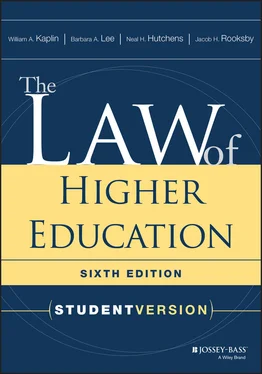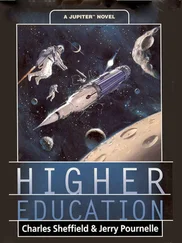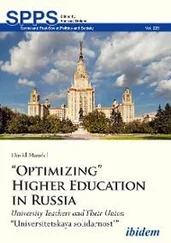Under other powers, and pursuing other priorities, the federal government also establishes processes for copyrighting works and patenting inventions of faculty members and others (see, for example, Section 11.3.2.3); for enrolling and monitoring international students (see Section 7.7.3); for resolving employment disputes involving unionized workers in private institutions (see Sections 4.3and 5.3); and for resolving other employment disputes concerning health and safety, wages and hours, leaves of absence, unemployment compensation, retirement benefits, and discrimination. In all these arenas, federal law is supreme over state and local law, and federal law will preemptstate and local law that is incompatible with the federal law.
Furthermore, the federal courts are the primary forum for resolving disputes about the scope of federal powers over education, and for enforcing the federal constitutional rights of faculty members, students, and others (see, for example, Sections 6.1and 9.4). Thus, federal court judgments upholding federal powers or individuals' constitutional rights serve to alter, channel, and check the governance activities of higher education institutions, especially public institutions, in many important ways.
Local governments, in general, have much less involvement in the governance of higher education than either state governments or the federal government. The most important and pertinent aspect of local governance is the authority to establish, or to exercise control over, community colleges. But this local authority does not exist in all states, since state legislatures and state boards may have primary governance authority in some states. Local governments may also have some effect on institutions' internal governance—and may superimpose their own structures and processes upon institutions—in certain areas such as law enforcement, public health, zoning, and local taxation. But local governments' authority in such areas is usually delegated to it by the states and is thus dependent on, and subject to being preempted by, state law (see Section 11.1.1).
External public governance structures and processes are more varied than those for internal governance—especially with regard to public institutions whose governance depends on the particular law of the state in which the institution is located (see Section 11.2.2). The statewide structures for higher education, public and private, also differ from state to state (see Section 11.2.1). What is common to most states is a state board (such as a state board of higher education) or state officer (such as a commissioner) that is responsible for public higher education statewide. This board or officer may also be responsible for private higher education statewide, or some other board or officer may have that responsibility. If a state has more than one statewide system of higher education, there may also be separate boards for each system (for example, the University of California system and the California State University system). In all of these variations, states are typically much more involved in external governance for public institutions than they are for private institutions.
At the federal level, there are also a variety of structures pertinent to the external governance of higher education, but they tend to encompass all postsecondary institutions, public or private, in much the same way. The most obvious and well known part of the federal structure is the U.S. Department of Education. In addition, there are numerous other cabinet-level departments and administrative agencies that have either spending authority or regulatory authority over higher education. The Department of Homeland Security (DHS), for instance, monitors international students while they are in the country to study (see Section 7.7.4); the Department of Health and Human Services (HHS) administers the Medicare program, which is important to institutions with medical centers; the Department of Labor administers various laws concerning wages, hours, and working conditions; the Occupational Safety and Health Administration (OSHA) administers workplace health and safety laws; several agencies have authority over certain research conducted by colleges and universities; and various other agencies, such as the National Institutes of Health (NIH) and the Department of Defense (DOD), provide research grants to institutions of higher education and grants or fellowships to faculty members and students.
At the local level, there is less public external governance than at the state and federal levels. The primary local structures are community college districts that have the status of local governments and community college boards of trustees that are appointed by or have some particular relationship with a county or city government. In some states, issues may arise concerning the respective authority of the community college board and the county legislative body (see Section 11.1.1). Some local administrative agencies, such as a human relations commission or an agency that issues permits for new construction, will also have influence over certain aspects of governance, as will local police forces.
Private external governance, like public external governance, also varies from institution to institution. Most postsecondary institutions, for example, are within the jurisdiction of several, often many, accrediting agencies. The agencies to which an institution is subject will depend on the region of the country in which the institution is located and the types of academic and professional programs that the institution offers. There are also various athletic conferences to which institutions may belong, depending on the level of competition, the status of athletics within the institution, and the region of the country; and there are several different national athletic associations that may govern an institution's intercollegiate competitions, as well as several different divisions with the primary association, the National Collegiate Athletic Association (NCAA) (see Section 12.1.3). Whether there is an outside sponsoring entity (especially a religious sponsor) with some role in governance will also depend on the particular institution, as will the existence and identity of labor unions that have established bargaining units. The influence that affiliated entities or grant-making foundations may have on institutional governance will also depend on the institution. One relative constant is the American Association of University Professors, which is concerned with all types of degree-granting postsecondary institutions nationwide.
Section 1.4. Sources of Higher Education Law
1.4.1 Overview.The modern law of postsecondary education is not simply a product of what the courts say, or refuse to say, about educational problems. The modern law comes from a variety of sources, some “external” to the postsecondary institution and some “internal.” The internal law, as described in Section 1.4.3below, is at the core of the institution's operations. It is the law the institution creates for itself in its own exercise of institutional governance. The external law, as described in Section 1.4.2below, is created and enforced by bodies external to the institution. It circumscribes the internal law, thus limiting the institution's options in the creation of internal law. (See Figure I.2, “The External Law Circumscribing the Internal Law,” in the General Introduction to this book, Section C.)
1.4.2 External sources of law.
1.4.2.1 Federal and state constitutions.Constitutions are the fundamental source for determining the nature and extent of governmental powers. Constitutions are also the fundamental source of guarantees of individual rights that limit government powers and protect citizens generally, including members of the academic community. The federal Constitution is by far the most prominent and important source of individual liberties. The First Amendment protections for speech, press, and religion are often litigated in major court cases involving postsecondary institutions, as are the Fourteenth Amendment guarantees of due process and equal protection. As explained in Section 1.5, these federal constitutional provisions apply differently to public and to private institutions.
Читать дальше












